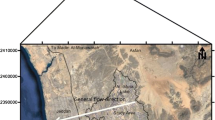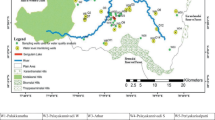Abstract
This study highlights the implications of selenium (Se) dispersion in groundwater flow regimes of Kahota Industrial Triangle area located adjacent to the Soan River, Islamabad. Initially, a regional groundwater 3-D flow model has been developed, calibrated to the known observed heads of 24 water wells, verified, and confirmed that convergence has actually arrived to satisfy the steady state condition. Later, the transient simulation was carried out adding in the known recharge, storage factor, porosity, and observed drawdown matched with the simulated drawdown that appears to fall in close agreement with a difference of 0.25 m. As such the steady state groundwater model has facilitated to understand the mechanism of groundwater flow regimes in reference to the implications of selenium dispersion from disposal of Kahota Industrial Triangle area. Thirty-five water samples were collected mainly from the industrial water wells for the evaluation of heavy metals. Selenium being the major contributor of pollution has been short listed to monitor its dispersion using a solute transport model modular three-dimensional transport model (MT3D). Chemical parameters related to selenium characteristics including horizontal and vertical transverse dispersivity/longitudinal dispersivity, effective molecular diffusion coefficient and bulk density of the porous medium of aquifers have been used in MT3D contaminant transport model. MT3D is run for 30 years in steady state condition. As usual first run did not produce the exact field conditions. Therefore, the contaminant transport model is calibrated against the 32 values of observed selenium concentrations in boreholes by minor adjustments in the chemical parameter values. The final calibration has been achieved with residual value of 3.88 × 10 − 5 Kg/m3. Seven hypothetical observation wells are used to monitor the selenium concentrations over a long-term period of time.
Similar content being viewed by others
References
Ahmad, Z., Ahmad, I., Gulraiz, A., & Ashraf, A. (2006). Hydrological analysis of Islamabad watershed area. Islamabad Journal of Science, 15, 80–97.
Ahmad, Z., Kausar, R., & Ahmad, I. (2009). Implications of depletion of groundwater levels in 3 layered aquifers and its management to optimize the supply demand in the urban settlement near Kahota Industrial Triangle area, Islamabad, Pakistan. Environmental Monitoring and Assessment, 172, 1–15. doi:10.1007/s10661-009-0983-9.
Ahmad, Z., & Khawaja, A. A. (1999). Three-dimension flow and solute transport modeling of the Eolian Aquifer in a uniform flow field of a chemical plant. Pakistan Journal of Hydrocarbon Research, 11, 59–74.
Ahmad, Z., Shaista, M., & Gulraiz, A. (1997). Evaluation of groundwater potential of Islamabad area using logs data of test holes drilled by OGDC. Pakistan Journal of Hydrocarbon Research, 9, 91–101.
Andrews, C. B., & Neville, C. J. (2003). Groundwater flow in a desert basin: Challenges of simulating transport of dissolved chromium. Groundwater, 41(2), 219–226.
Ashraf, A., & Ahmad, Z. (2008). Regional groundwater flow modeling of upper Chaj Doab, Indus Basin. Geophysical Journal International (GJI), 173, 17–24. doi:10.1111/j.1365-246X.2007.03708.x.
Bakker, M. (2003). A Dupuit formulation for modeling seawater intrusion in regional aquifer systems. Water Resources Research, 39(5), 1131. doi:1029/2002WR001710.
Barth, G. R., Hill, M. C., Illangasekare, T. H., & Rajaram, H. (2001). Predictive modeling of flow and transport in a two-dimensional intermediate-scale, heterogeneous porous medium. Water Resources Research, 37(10), 2503–2512.
Bedient, P. B., Rifai, H. S., & Newell, C. J. (1999). Groundwater contamination transport and remediation (2nd ed.). Upper Saddle River, NJ 07458: Prentice Hall, Inc.
Bender, F. K., & Raza, H. A. (Eds.) (1995). Geology of Pakistan Tutte Druckerei GmbH, Salzweg-passau.
Boutt, D. E., Hyndman, D. W., Pijanowski, B. C., & Long, D. T. (2001). Identifying potential land-use-derived solute sources to stream baseflow using groundwater models and GIS. Groundwater, 39(1), 24–34.
Brown, J. G., & Glynn, P. D. (2003). Kinetic dissolution of carbonates and Mn oxides in acidic water—measurement of in situ field rates and reactive transport modeling. Applied Geochemistry, 18(8), 1225–1239. doi:10.1016/S0883-2927(03)00010-6.
Conan, C., Bouraoui, F., Turpin, N., de Marsily, G., & Bidoglio, G. (2003). Modeling flow and nitrate fate at catchment scale in Brittany (France). Journal of Environmental Quality, 32, 2026–2032.
Copoulos, D., & Sehayek, E. (1986). Modeling leaching production from municipal landfills. Journal of Environmental Engineering, 112(5), 849–866.
Elci, A., Molz, F. J., & Waldrop, W. R. (2001). Implications of observed and simulated ambient flow in monitoring wells. Groundwater, 39(6), 853–862.
EPA (1999). Current drinking water standards. U.S. Environmental Protection Agency, Office of Groundwater and Drinking Water, Washington, DC. http://www.epa.gov/safewater/mcl.html.
Faidi, H. A., Garcia, L. A., & Albertson, M. M. (2002). Development of a model for simulation of solute transport in a stream-aquifer system. Environmental Modeling & Assessment, 7(3), 191–206.
Feehley, C. E., Zheng, C., & Molz, F. J. (2000). A dual-domain mass transfer approach for modeling solute transport in heterogeneous porous media, application to the MADE site. Water Resources Research, 36(9), 2501–2515.
Harrar, W. G., Sonnenborg, T. O., & Henriksen, H. J. (2003). Capture zone, travel time, and solute-transport predictions using inverse modeling and different geological model. Hydrogeology Journal, 11(5), 536–548.
Holder, A. W., Bedient, P. B., & Dawson, C. N. (2000). FLOTRAN, a 3-D groundwater model, with comparison to analytical solutions and other models. Advances in Water Resources, 23, 517–530.
Hooshmand, G. S. (1992). Selenium transport and transformation modeling in soil column under transient unsaturated flow field. M. S. Dissertation.
Hutson, J. L., & Wagenet, R. J. (1989). Leaching estimation and chemistry model. A process based model of water and solute movement transformations, plant uptake and chemical reactions in the unsaturated zone (Version 20, p. 148). New York: Department of Agronomy, Cornell University.
Julian, H. E., Boggs, J. M., Zheng, C., & Feehley, C. E. (2001). Numerical simulation of a natural gradient tracer experiment for the natural attenuation study: Flow and physical transport. Groundwater, 39(4), 534–545.
Kausar, R., & Ahmad, Z. (2008). Determination of toxic inorganic elements pollution in groundwaters of Kahota Industrial Triangle Islamabad, Pakistan using inductively coupled plasma mass spectrometry. Environmental Monitoring and Assessment. doi:10.1007/s10661-008-0539-4.
Langevin, C. D. (2003). Simulation of submarine groundwater discharge to a marine estuary: Biscayne Bay, Florida. Groundwater, 41(6), 758–771.
Liu, G., Zheng, C., & Gorelick, S. M. (2004). Limits of applicability of the advection-dispersion model in aquifers containing connected high-conductivity channels. Water Resources Research, 40, W08308. doi:10.1029/2003WR002735.
McMahon, J., Heathcote, Carey, M., & Erskine, A. (2001). Guide to good practice for the development of conceptual models and the selection and application of mathematical models of contaminant transport processes in the subsurface. National Groundwater & Contaminated Land Centre Report NC/99/38/2A USA.
Mehl, S. W., & Hill, M. C. (2001). Comparison of solute transport solution techniques and their effect on sensitivity analysis and inverse modeling results. Groundwater, 39(2), 300–307.
Mujtaba, G., & Ahmad, Z. (2007). Management of groundwater resources in Punjab, Pakistan, using a groundwater flow model. Journal of Environmental Hydrology, 15(31), 1–14.
Prommer, H., Barry, D. A., & Zheng, C. (2003). MODFLOW/MT3DMS based reactive multicomponent transport modeling. Groundwater, 41(2), 247–257.
Shamrukh, M., Corapcioglu, M. Y., & Hassona, F. A. A. (2001). Modeling the effect of chemical fertilizers on groundwater quality in the Nile Valley aquifer, Egypt. Groundwater, 39(1), 59–67.
Shifang, F. (1991). Selenite adsorption /desorption in the California soils. PhD, Dissertation Soil Science, 259.
Soanian from Wikipedia, the free encyclopedia. Retrieved October 12, 2007 from http://en.wikipedia.org/wiki/Soan_Culture.
Wang, F., & Bright, J. (2004). Scale effect and calibration of contaminant transport models. Groundwater, 42(5), 760–766.
Wilber, C. G. (1980). Toxicology of selenium: A review. Clinical Toxicology, 17, 171.
Williams, V. S., Iqbal Sheikh, M., Pasha, M. K., Ali Khan, K. S., & Reza, Q. (1992). Preliminary report on the environmental geology of the Islamabad-Rawalpindi Area, Pakistan. In Proceedings of the first South Asia geological congress Islamabad.
Zheng, C., & Bennett, G. D. (1997). Applied contaminant transport modeling: Theory and practice. New York: Wiley.
Zheng, C., & Gorelick, S. M. (2003). Analysis of solute transport in flow fields influenced by preferential flow paths at the decimeter scale. Groundwater, 41(2), 142–155.
Zheng, C., & Wang, P. P. (2002). A field demonstration of the simulation-optimization approach for remediation system design. Groundwater, 40(3), 258–265.
Author information
Authors and Affiliations
Corresponding author
Rights and permissions
About this article
Cite this article
Ahmad, Z., Kausar, R. & Ahmad, I. Highlighting the implications of selenium dispersion from disposal of Kahota Industrial Triangle area, Islamabad, Pakistan using three-dimension solute transport model. Environ Monit Assess 167, 565–579 (2010). https://doi.org/10.1007/s10661-009-1073-8
Received:
Accepted:
Published:
Issue Date:
DOI: https://doi.org/10.1007/s10661-009-1073-8




